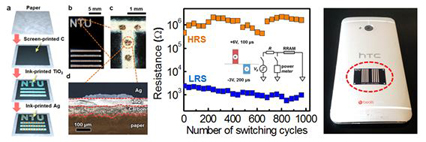
 |
||
|
::: NTU Research Team Discovers Method to Print Paper Memory |
||
|
Integrated circuit boards, a piece of hardware that is indispensable to our daily lives, yet whose production is as complicated and unfriendly as it looks. Now, imagine being able to print an IC board in the comforts of your own home. Sound impossible? Not anymore, according to an innovative study conducted by a research team in National Taiwan University. The idea behind the study was to find a way to produce convenient yet sustainable circuit boards at a low cost. To reach this goal, the team looked at the materials. Compared to the traditional silicon or plastic IC boards, “paper” seemed to be the obvious substitution as it is portable, dissolvable, foldable, recyclable, and most importantly, affordable. In combination with the seasoned printing technology and modern software application, it is possible to mass produce IC boards at the office or in the comforts of one’s own home. In turn, this will allow for a much wider application of the technology. So how is this made possible? First of all, the texture of paper as a base material has been greatly enhanced with the technological development of active and passive electronic components, therefore, major concerns such as paper’s smooth and absorbent properties are able to be resolved. However, for paper to become a suitable medium to function as an electronic component, another memory component needs to provide storage and application functionalities. However, there had yet to be a significant development in this aspect as memory component’s complexity and need for a level platform were major obstacles that needed to be overcome. As such, the study of paper memory at NTU is considered a major breakthrough in its field. The study entitled “Paper Memory by All Printing Technology” is conducted by Professor Jr-Hau (JH) He (何志浩) of Graduate Institute of Photonics and Optoelectronics, Professor Ying-Chih Liao (廖英志) of the Department of Engineering, and Professor Lee Si-Chen (李嗣涔) of the Graduate Institute of Electronic Engineering. With passion, creativity, and a comprehensive execution ability, the study’s main executor, Der-Hsien Lien (連德軒), was able to complete the research through the combination of knowledge across the various fields of electronics, materials, chemical engineering.
As indicated in the image, using an inkjet printer, a three layer nonvolatile resistive memory structure capable of multiple resistive switching is printed onto paper. Now that the inkjet printer can print the wires, patterns and memory components all at the same time, the production time is reduced by half, and the traditional method of producing circuit boards is, in comparison, far less efficient in terms of time, material, and energy consumption. This breakthrough can be utilized in the production of memory stickers which can be easily attached to any electronic appliance, such as the cell phone, the battery, and even the human body. In the future, it is expected that the technology can be further applied as a wearable electronic component, a paper electronic component, or be utilized as a direct memory upgrade component for consumer electronic products. In addition, it is estimated that paper memory technology can also vastly expand the scope of 3D printing to include the production of a functional electronic component. As printed circuits have a vastly growing output value, this new technology which is both environmental and cost effective is expected to play a significant role in the market. The study has already received international attention and the paper is to be presented at the 2014 Symposia on VLSI Technology and Circuits in Honolulu in June. The VLSI Symposia is an international conference on semiconductor technology and circuits, and is considered one the world’s leading and most influential symposiums in its field. This year’s event will feature IT heavyweights such as Intel, IBM, and Qualcomm, as well as experts from all over the globe. This would be the first NTU research paper to be presented at the VLSI Technology Program, where it will be featured as a highlight presentation. |
||
No. 1, Sec. 4, Roosevelt Road, Taipei, 10617 Taiwan(R.O.C.)
Phone: +886-2-3366-3366 Fax: +886-2-2362-7651
